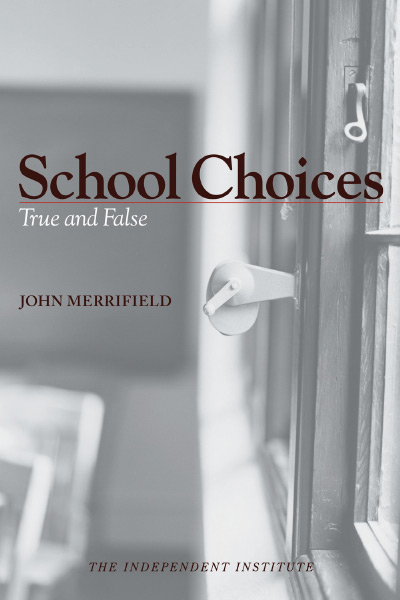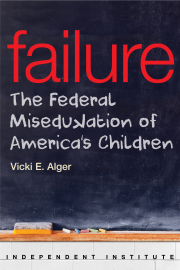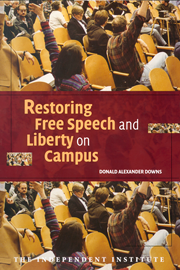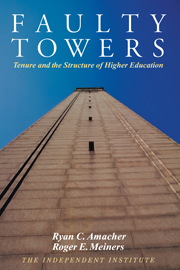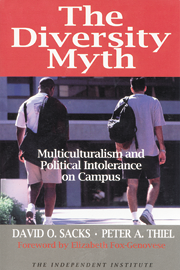| List Price: | ||
| Price: | $3.99 | |
| Discount: | $11.96 (Save 75%) |
| Formats |
Paperback |
eBook |
| List Price: | ||
| Price: | $3.99 | |
| Discount: | $11.96 (Save 75%) |
| Formats |
Paperback |
eBook |
Overview
The school choice movement has gained political momentum in recent years, with programs having been established in Milwaukee, Florida, Texas, and elsewhere. But today’s programs are nothing like the “free market in education” proposed four decades ago by the early proponents of school choice.
Economist John Merrifield shows that the “school choice” movement has become mired in false alternatives, petty distinctions, and diminished vision. Yet, he argues that programs providing real educational choices must not be allowed to fail like so many government programs—a freely competitive market for education must remain the ultimate goal. School Choices: True and False charts a course for the achievement of this goal.
Contents
Chapter 1: Introduction
Chapter 2: Where We Stand—The Achievement Deficit and its Causes
Chapter 3: Problems of the Reform Debate
Chapter 4: Problems with Current Voucher and Choice Reforms
Chapter 5: What Side-Tracked The School Choice Movement?
Chapter 6: Loose Lips Sink Causes
Chapter 7: Getting There—Back Up, then Move Forward
Chapter 8: Conclusion
Index
Detailed Summary
- Despite two decades of educational reform frenzy, the substantial academic gains needed by “A Nation at Risk” are nowhere to be seen. Per-pupil spending of private schools per year—$3,116 (1993-94 data) according to the National Center for Education Statistics—was much lower than public schools’ per-pupil expenditures of $6,500. That imbalance continues today.
- Private-school salaries are approximately two-thirds of public-school salaries, although private-school teachers typically report higher levels of job satisfaction than do public-school teachers.
- American public education is a low-performing system overall, and not just one with isolated low-performing schools.
- Reliance on the “More-of-the-Same-Harder” approach to school reform defies recent experience with the failure of identical proposals in other states.
- A not widely recognized source of poor performance is families’ lack of choices from a menu of specialized schools. Increased specialization by schools and educators would improve productivity, student engagement, and address concerns about “choice,” such as diversity and stratification.
- Expecting substantial achievements without fundamental change in the current K–12 system’s key elements defies knowledge about human nature, differences in how children learn, the importance of choice and specialization, and centuries of experience with markets and politics. Existing policies assume that competition, incentives, specialization, and learning style diversity are not important.
- Widespread fallacies include: “better means good,” restriction-laden choice is an insightful experiment, choice will necessarily produce a larger version of the existing private-school sector, most schools are fine, and low performing schools are concentrated in the low-income inner city.
- Most prominent choice-based proposals neglect the need for system-wide transformation and focus on limited escape from the worst schools. However, legislation by former New Mexico Governor Gary Johnson and California’s defeated Proposition 38 are model proposals to emulate because they would help create the necessary foundations for beneficial competition.
- Genuine competition requires flexible, market-determined prices for school services and ending discriminatory practices by state and federal bureaucrats against private school users.
- Loose lips sink causes: Many prominent choice advocates jeopardize the political feasibility of choice-based system-wide transformation with their careless analyses and hype about misleading, alleged “experiments.”
The declining quality of American public schools has frustrated parents, perplexed the educational establishment and given politicians endless opportunities to proclaim their support for reform. Increasing numbers of students have found relief in private schools and homeschooling, but for most families, flight from the public schools in not a viable option.
Advocates of “school choice” point out that attempts to fix the public (government) schools have been piecemeal at best. In contrast, publicly funded tuition vouchers, they argue, would reform American schooling at the system-wide level and thereby dramatically and continuously improve K-12 education. But would it?
According to John Merrifield, author of School Choices: True and False, school choice advocates have—or had—the right idea. A competitive education industry—fostered by vouchers—would greatly improve the quality of education. However, argues Merrifield, most school-choice proposals are too small and too limited in scope to fulfill their promise. They simply do not offer enough choice. Rather than settle for “dumbed-down” versions of school choice, Merrifield invites readers to take the notion of choice in education seriously. Anything less, he argues, will shortchange students and make true reform less likely.
School Choices calls for major changes in research practices, debating tactics, and political strategy. It describes a school-reform proposal that would utilize market forces, especially genuine competition, to focus on the fate of children rather than the public school system, which is nothing more than a governing and funding process. It also offers a detailed discussion of how such a policy would be implemented.
The Achievement Deficit
Horror stories about the decline of public schools abound and have greatly reduced expectations for schools and students. The failure of many high school graduates to read at or above grade level, perform well on standardized tests, distinguish the two World Wars, or identify key countries on a map is now taken for granted. Other symptoms of the decline of public schools include the growth of homeschooling (despite the advantages of specialization); parental apathy; and state takeovers of poorly managed school districts.
A key source of the academic achievement deficit is the public schools’ typical employment of a one-size-fits-all approach to teaching, despite students’ diverse learning styles. Attempts to improve public schools fail because reform measures are politically driven, personnel burnout and debilitating micromanage-ment are common, and little effort is made to provide educators and administrators with incentives to improve.
At the root of these problems lies the monopolistic design of the public school system. Because few families can afford to leave them, most public schools face no real competition. Thus they are bureaucratic and costly, fail to continuously innovate, and do not take suggestions well.
Myths of the School Reform Debate
Criticism of the public school system is often misunderstood as an attack on education per se. School choice advocates are less likely to accept this falsehood, but they do hold other misconceptions that serve to undermine system-wide reform. For example, many assume that public school bureaucracies (i.e., “school districts”) must remain with us always. This myth assures that the school choice debate will be confined to the context of government bureaucracy. Many also erroneously hold that only inner-city public schools need reform. In reality, students in suburban public schools—and private schools—often perform poorly compared to students from other industrialized countries.
Problems with Current Voucher and Choice Reforms
Perhaps the biggest myth about school choice is that current choice programs constitute a meaningful experiment. They don’t. Current voucher programs are limited to such a small number of students and they have so many restrictions that they don’t look at all like a competitive school system. At best, current choice programs are escape hatches for a few students. But even these students would be better off under a fully competitive school system, because such a system would offer greater specialization of teaching styles, and would benefit from continuous improvements (as is routine in other competitive industries). “Public-school choice, including charter schools, will not transform our school system any more than the freedom to choose a state-owned store transformed the Soviet Union,” writes Merrifield.
The Milwaukee and Florida Programs
Milwaukee’s voucher program is flawed on several counts. Participation is limited to only 15 percent of the Milwaukee public school district’s students. Also, the voucher is worth only half of the district’s cost to educate a student, and parents are not allowed to augment it with their own money. (Because participating private schools must accept vouchers as full payment, the ban amounts to a price control—which would create a shortage, were it not for the participation caps.) If Milwaukee public schools have improved as a result, their gains have been marginal at best.
Florida’s school voucher program (and the proposals recently rejected in Texas and Michigan) also caps the value of vouchers to well below the per pupil costs of public schooling. And it aims to improve only those schools the government deems to be the worst—and to push them above some minimum standard, not to improve the quality of all schools.
In contrast, a truly competitive school system would encourage the development of a large educational “menu.” This would enable schools to better accommodate students with diverse learning styles or who could use special help to catch up to their private-school peers. Limited school choice programs, in contrast, have been too small to make this option feasible, resulting in some voucher students returning to their prior school.
Charter Schools and Tax Credits
Charter schools and tax-credit proposals often compete for attention with vouchers. Charter schools can act as escape hatches to help a small number of students, but the small number of charter schools cannot systematically improve entire public school systems. Charter schools may also displace some private schools or shrink their enrollments, reducing desirable competition in the education industry. And, charter schools are seldom as free to innovate as many people believe.
Some choice advocates favor tuition tax credits instead of vouchers, because they believe that tax credits would be less susceptible to government regulation than would voucher-accepting schools. Tax credits would also serve as an escape hatch, but they are unlikely to transform education: Neither the size of the tax credit nor the number of participants would be sufficiently large to unleash market forces great enough to improve the education system. Low-income families, with little ability to supplement a voucher, would have to choose between a public-school system that has served them badly and the cheapest private schools.
What Sidetracked Choice Advocacy?
The modern voucher debate began with Nobel Laureate economist Milton Friedman’s 1962 book, Capitalism and Freedom. The voucher concept gained critical acclaim—that is, until detailed proposals were put on the table.
Real-world proposals have omitted some of the most important features of an effective voucher program. First, the market for education must be fully contestable, meaning that no producer is assured a market share and that more than minor portions of market share are at stake. Second, because economic efficiency requires prices to reflect changes in production costs and consumer preferences, the schools should be free to set their tuition rates without having to worry about whether their pricing policies would jeopardize a parent’s eligibility for direct government support or indirect support through vouchers or tax credits.
Loose Lips Sink Causes
Despite their important differences with a universal voucher plan, education writers routinely imply that the results of the highly limited programs that have been adopted shed light on how well a large-scale voucher system would work. But this is false. Thus, when a newspaper headline proclaims, “School Vouchers on Trial in Milwaukee and Cleveland,” or implies that school choice programs are modeled after the G.I. Bill or constitute a “big step in the direction of accountability,” the media does a disservice to thoughtful public-policy debate.
Even economists, who are trained to distinguish between meaningful data and statistical noise, have been erroneously claiming that current voucher programs are “market-based” and “can predict the performance of a universal voucher plan.” This error contributes to the dangerously narrow focus of the school choice debate.
Many commentators also erroneously assume that current private-school practices and outcomes are the alternative to public schools. Not so! The constraints, incentives, and available resources will be very different in a competitive education industry.
The Road to Reform
To reorient the school choice debate, advocates must keep in mind that the goal is to improve education for all students—not just those in an allegedly small subset of under-performing schools. To that end, school choice advocates should emphasize that under genuine school choice, the number of schools and diversity of teaching approaches would be significantly larger than under the current system.
And school choice advocates should avoid using the word “experiment” to describe programs that are merely escape hatches for a few students. To meet criticism that school choice is “risky,” choice advocates could ask skeptics which part of the current system they would miss.
Government employee unions have often opposed school choice, but “dedicated teachers have almost as much to gain from competition as their students do,” writes Merrified. Because school choice would foster educational innovation and variety, it would also encourage continuous teacher development—and reward teachers accordingly. In fact, “the growing difficulty of recruiting and retaining teachers may be what ultimately forces an overhaul of the K–12 system,” writes Merrifield, who then concludes:
“The greatest threats to progress are low expectations and misleading alleged experiments. We need to achieve real competition in only one reasonably populous area to assure that eventually it will exist virtually everywhere. If we keep our eyes on the goal and are not distracted by half-measures..., it can happen quickly, much like the sudden collapse in 1989 of the socialist regimes of eastern Europe. Even the political worst-case scenario can only delay competition. The intense interest in K–12 reform will eventually exhaust all the other options. The alternatives to competition are inevitable disappointments—that has already been proven many times.”
Praise
“Professor Merrifield asks this question: what is meant by and what is the intended consequence of reforms bearing such labels as vouchers, school choice, charter schools, privatization, and competition? This book brilliantly and clearly exposes the superficiality and extraordinary fuzziness of those labels.”
—Seymour B. Sarason, Professor Emeritus of Psychology, Yale University
“In School Choices, Merrifield has produced a scholarly call-to-arms...deserves serious consideration by the strategists of the choice movement.”
—Eric A. Hanuskek, Senior Fellow, Hoover Institution
“It is always important to subject movements to re-evaluation, so School Choices: True and False is a useful publication . . . This monograph reminds us of the ultimate goal, which is universal choice. This is a valuable contribution.”
—Clint Bolick, Vice President, Institute for Justice
“Creating an authentic market is one necessary condition of ending the servitude of the working class and the poor to the government schools. . . . As Professor Merrifield well knows, the integrity of the family and its contractual authority over curriculum and method are foundational objects that will require prudence in selection of policy measures. So understood and domesticated, his book, School Choices, is an important and very timely contribution.”
—John E. Coons, Professor of Law, University of California, Berkeley
“School Choices is a provocative and first rate analysis of how the school choice idea has been dumbed down and what it will take to develop the critical elements of a competitive education industry.”
—Bruno V. Manno, former Assistant Secretary of Education for Policy and Planning, U.S. Department of Education and former Director of Planning for the Office of Educational Research and Improvement
Author
John Merrifield is an associate professor of economics at the University of Texas, San Antonio, and a Senior Research Associate at the Education Policy Institute, Washington, D.C.


